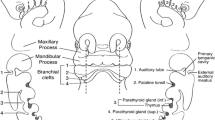Abstract
First and second branchial arch syndromes (BAS) manifest as combined tissue deficiencies and hypoplasias of the face, external ear, middle ear and maxillary and mandibular arches. They represent the second most common craniofacial malformation after cleft lip and palate. Extended knowledge of the embryology and anatomy of each branchial arch derivative is mandatory for the diagnosis and grading of different BAS lesions and in the follow-up of postoperative patients. In recent years, many new complex surgical approaches and procedures have been designed by maxillofacial surgeons to treat extensive maxillary, mandibular and external and internal ear deformations. The purpose of this review is to evaluate the role of different imaging modalities (orthopantomogram (OPG), lateral and posteroanterior cephalometric radiographs, CT and MRI) in the diagnosis of a wide spectrum of first and second BAS, including hemifacial microsomia, mandibulofacial dysostosis, branchio-oto-renal syndrome, Pierre Robin sequence and Nager acrofacial dysostosis. Additionally, we aim to emphasize the importance of the systematic use of a multimodality imaging approach to facilitate the precise grading of these syndromes, as well as the preoperative planning of different reconstructive surgical procedures and their follow-up during treatment.


















Similar content being viewed by others
References
Moore K (1988) The developing human. Clinically oriented embryology, 4th edn. Saunders, Philadelphia
Castillo M, Mukherji SK (1995) Imaging of facial anomalies. Curr Probl Diagn Radiol 25:169–188
Castillo M (1994) Congenital abnormalities of the nose: CT and MR findings. AJR 162:1211–1217
Cobourne MT (2000) Construction for the modern head: current concepts in craniofacial development. J Orthod 27:307–314
Vento AR, LaBrie RA, Mulliken JB (1991) The O.M.E.N.S. classification of hemifacial microsomia. Cleft Palate Craniofac J 28:68–76
Goske MJ, Applegate KE, Boylan J et al (2008) The ‘Image Gently’ campaign: increasing CT radiation dose awareness through a national education and awareness program. Pediatr Radiol 38:265–269
Goske MJ, Applegate KE, Boylan J et al (2008) The Image Gently Campaign: working together to change practice. AJR 190:273–274
The Alliance for Radiation Safety in Pediatric Imaging. www.Imagegently.org
Verdun FR, Gutierrez D, Vader JP et al (2008) CT radiation dose in children: a survey to establish age-based diagnostic reference levels in Switzerland. Eur Radiol 18:1980–1986
Galanski M, Nagel HD, Stamm G (2007) Results of a federation inquiry 2005/2006: pediatric CT X-ray practice in Germany. Rofo 179:1110–1111
Shrimpton PC, Hillier MC, Lewis MA et al (2006) National survey of doses from CT in the UK: 2003. Br J Radiol 79:968–980
Brisse HJ, Aubert B (2009) CT exposure from pediatric MDCT: results from the 2007–2008 SFIPP/ISNR survey. J Radiol 90:207–215
Ilizarov GA (1988) The principles of the Ilizarov method. Bull Hosp Jt Dis Orthop Inst 48:1–11
Ortiz Monasterio F, Molina F, Andrade L et al (1997) Simultaneous mandibular and maxillary distraction in hemifacial microsomia in adults: avoiding occlusal disasters. Plast Reconstr Surg 100:852–861
Scolozzi P, Herzog G, Jaques B (2006) Simultaneous maxillo-mandibular distraction osteogenesis in hemifacial microsomia: a new technique using two distractors. Plast Reconstr Surg 117:1530–1541
Charrier JB, Bennaceur S, Couly G (2001) Hemifacial microsomia. Embryological and clinical approach. Ann Chir Plast Esthet 46:385–399
Tessier P (1976) Anatomical classification of facial, cranio-facial and latero-facial clefts. J Maxillofac Surg 4:69–92
Rahbar R, Robson CD, Mulliken JB et al (2001) Craniofacial, temporal bone, and audiologic abnormalities in the spectrum of hemifacial microsomia. Arch Otolaryngol Head Neck Surg 127:265–271
Carvalho GJ, Song CS, Vargervik K et al (1999) Auditory and facial nerve dysfunction in patients with hemifacial microsomia. Arch Otolaryngol Head Neck Surg 125:209–212
Pruzansky S (1969) Not all dwarfed mandibles are alike. Birth Defects 1:120–129
Papadopoulos MA, Christou PK, Christou PK et al (2002) Three-dimensional craniofacial reconstruction imaging. Oral Surg Oral Med Oral Pathol Oral Radiol Endod 93:382–393
Robson CD (2006) Congenital hearing impairment. Pediatr Radiol 36:309–324
Binaghi S, Gudinchet F, Rilliet B (2000) Three-dimensional spiral CT of craniofacial malformations in children. Pediatr Radiol 30:856–860
Gonzalez GE, Caruso PA, Small JE et al (2008) Craniofacial and temporal bone CT findings in cleidocranial dysplasia. Pediatr Radiol 38:892–897
Author information
Authors and Affiliations
Corresponding author
Rights and permissions
About this article
Cite this article
Senggen, E., Laswed, T., Meuwly, JY. et al. First and second branchial arch syndromes: multimodality approach. Pediatr Radiol 41, 549–561 (2011). https://doi.org/10.1007/s00247-010-1831-3
Received:
Revised:
Accepted:
Published:
Issue Date:
DOI: https://doi.org/10.1007/s00247-010-1831-3




